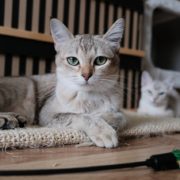Love Animals? Enhance Your Career With an Animal Behaviour Course!
Whether you work voluntarily or professionally, managing animals is far safer when you understand them. Our Certificate of Animal Behaviour will give you insights into behavioural ecology, ethology, and animal psychology, with an emphasis on ethical animal care and welfare. You’ll learn the scientific principles behind why animals behave as they do, focusing on instincts, learned behaviours, and interactions with humans and other species.
Learning Outcomes
Outcomes achieved by undertaking an animal behaviour course include:
- Introduction to animal behaviour studies
- Ethology
- Behavioural ecology
- Animal psychology
- Evolutionary basis of behaviour
- Natural selection and behaviour
- Adaptation and fitness
- Innate versus learned behaviour
- Behavioural strategies
- Animal welfare
- Human-animal relationships
- Anatomy of the nervous system
- Anatomy and behaviour
- Autonomic nervous system
- Hormonal influences on behaviour
- Genetics and inherited traits
- Understanding sensory perception in animals
- Theories of learning
- Classical conditioning
- Operant conditioning
- Social learning
- Modelling
- Habituation
- Desensitisation
- Counterconditioning
- Applications in animal training and rehabilitation
- Miscommunication and its behavioural implications
- Human-animal communication
- Social hierarchies
- Dominance behaviours
- Behavioural characteristics of dogs, cats, horses, birds, reptiles, amphibians and exotics
- Understanding wildlife behaviour
- Stress, anxiety, and fear in animals
- Strategies for behavioural modification
- Behavioural trade-offs of domestication
- Influence of environment and captivity
- Ethics of working with animals
- Conservation and wildlife behaviour
And more!
Edward Thorndike: The Law of Effect
One of the the theories you will learn about in our animal behaviour course is Thorndike’s Law of Effect. Thorndike is famous in the world of psychology for his work on learning theory. He suggested that “responses that produce a satisfying effect in a particular situation become more likely to occur again in that situation, and responses that produce a discomforting effect become less likely to occur again in that situation”. Thorndike was the first to apply psychological principles, in particular the concept of reinforcement, to the area of learning.
He studied learning in animals — usually cats — and devised a classic experiment where he used a puzzle box to empirically test the laws of learning. He placed a cat in the puzzle box, and it was then encouraged to escape the box to reach a piece of fish that was placed outside. Thorndike would then measure how long it would take them to escape, and noticed that cats experimented with different ways to escape the puzzle box to reach the fish.
Eventually, most of the cats would stumble upon a lever which opened the cage. When the cat had escaped, it was put in the cage again, and Thorndike would again measure the time it took the cat to escape. In successive trials, the cats would learn that pressing the lever would have favourable consequences, and they would adopt their behaviour and become increasingly quick at pressing the lever.
30 Fascinating Animal Behaviour Facts
Our globe is home to more than one million known animal species, and many of them exhibit fascinating behaviour traits. Here are thirty facts that will provide an abundance of inspiration for undertaking an animal behaviour course.
- Wild dolphins call each other by name with “signature whistles”.
- Young goats pick up accents from each other.
- Humpback whale songs spread like “cultural ripples from one population to another.”
- Some African elephants have a specific alarm call that means “human”.
- Horses use facial expressions to communicate with each other.
- Azara’s night monkeys are more monogamous than humans.
- Male gentoo penguins “propose” to females by giving them a pebble.
- Barn owls are normally monogamous, but about 25 per cent of mated pairs “divorce.”
- African buffalo herds display voting behaviour in which individuals register their travel preference by standing up, looking in one direction and then lying back down. And only adult females can vote!
- If a honeybee keeps “dancing” in favour of an unpopular nesting site, other workers head butt her to help the colony reach a consensus.
- It was recently discovered that the bone-house wasp stuffs the walls of its nest with dead ants.
- Myotonic goats faint when they are startled. The breed characteristic, known as Myotonia Congenita, is a condition where their muscle cells experience prolonged contraction which causes them to freeze and fall over.
- Horned lizards have a variety of ways to avoid predation, including squirting blood out of their eyes. They do this by stopping blood flowing to their head which increases the pressure and ruptures the tiny vessels around their eyes.
- A pistol shrimp stuns its prey by snapping its claw so quickly that it makes a sound that’s louder than a gun shot.
- Some army ants are completely blind, which means they can become disoriented and march in circles until they die of exhaustion.
- Female bower birds are attracted to beautiful homes. Which is why the males decorate dry grass with flowers and pebbles and spend hours on colour coordination!
- Female cuckoos shirk all responsibility when it comes to parenting. They lay their eggs in other nests and then abandon them. Eventually the baby bird is fed and raised by another bird, often indirectly killing its “fake” siblings.
- Elephants are known to display emotional behaviour, particularly rituals related to death. When they come across elephant bones, they will stop and remain silent. If an elephant from their own herd passes away, other elephants will stand by the body for hours, even abstaining from food and water.
- Crows hold grudges and have an amazing memory capacity for those who have wronged them. Crows that have been captured will remember their abductors, even going as far as dive bombing them when they are spotted.
- Meerkats teach their babies or “pups” rather than relying on trial and error. Their main diet is scorpions, but instead of allowing pups to sting themselves when eating them, the parent will give their pups dead scorpions as practice. As the pups improve, the parents bring back livelier scorpions until they can eventually catch and eat live ones on their own.
- Male giraffes drink a female’s urine to work out if they are ready to mate. Their urine is flavoured with certain hormones that signify if they are ready to become pregnant.
- Moths and butterflies drink the tears of mammals, turtles and crocodiles to obtain the essential nutrients found in salt.
- Clownfish start out as male, but once the group’s female dies, the largest male morphs into a female.
- Teenage elephants become delinquents if they don’t have strong parenting. Elephants will also harass people and villages if older members of their group are lost due to poaching.
- The Australian marsupial, antechnius, mate for two or three weeks non-stop. This often leads to exhaustion and then death.
- Dolphins sleep with one eye open and half of their brain still awake. This helps them watch out for predators and obtain air. After about two hours, their awake brain hemisphere will go to sleep and the other side will wake up.
- Komodo dragons can have virgin births, and in science, this is called parthenogenesis. Her eggs fused with other materials in her body to form embryos. So essentially, her babies have the same DNA as her.
- Urchin crabs carry sea urchins around on their backs to protect themselves from predators. Other “decorator” crabs will put corals, seaweed and sponges on their bodies to camouflage themselves.
- Assassin bugs put balls of dead ants on their backs to confuse predators. They kill them by first paralysing them and then eating their insides.
- Secretary birds viciously kick their prey — snakes, lizards and insects — to death with a force that’s five times their body weight.
Gain foundational knowledge of animal behaviour which will enable you to safely and effectively interact or work with animals with an animal behaviour course, such as our Certificate of Animal Behaviour






